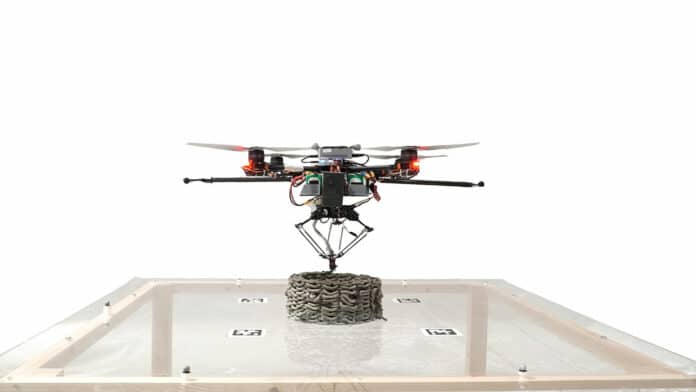3D printing is gaining momentum in the construction industry. Both on-site and in the factory, static and mobile robots print materials for use in construction projects, such as steel and concrete structures.
Researchers from Switzerland’s Empa institute, the University of Pennsylvania, and the Imperial College London have created a swarm of bee-inspired drones that can collectively 3D print material while in flight, allowing limitless manufacturing for building and repairing structures. Under human control, these flying robots, inspired by natural builders like bees and wasps, work as a team to print 3D materials for building or repairing structures while flying.
The system, called Aerial Additive Manufacturing (Aerial-AM), actually incorporates two types of quadcopter drones, which fly autonomously and communicate with one another. Researchers develop BuilDrones for depositing materials during flight, and quality-controlling ScanDrones continually measure the BuilDrones’ output and inform their next manufacturing steps.

A scalable multi-robot three-dimensional (3D) printing and path-planning framework enable robot tasks and population size to adapt to variations in print geometry and robot behavioral adaption. The 3D-printing drones are fully autonomous in flight, but there is a human controller in the loop that can monitor progress and intervene if necessary, based on the information provided by the drone.
In order to test the concept, the researchers developed four cement-like mixtures for the drones to build with. Throughout the build, the drones assess the printed geometry in real time and adapt their behavior to ensure they meet the build specifications, with a manufacturing accuracy of five millimeters. The proof-of-concept prints included a cylinder 2.05 meters high consisting of 72 layers of polyurethane-based foam material and a cylinder 0.18 meters high consisting of 28 layers of a custom-designed structural cement-like material.
“We’ve proved the concept that drones can work autonomously and in tandem to construct and repair buildings, at least in the lab. This scalable solution could help construction and repair in difficult-to-reach areas, like tall buildings,” the lead researcher Mirko Kovac said.
The technology offers future possibilities for building and repairing structures in unbounded, high, or other hard-to-access locations. Next, the researchers will work with construction companies to validate the solutions and provide repair and manufacturing capabilities. They believe the technology will provide significant cost savings and reduce access risks compared to traditional manual methods.
Journal reference:
- Ketao Zhang, Pisak Chermprayong, Feng Xiao, Dimos Tzoumanikas, Barrie Dams, Sebastian Kay, Basaran Bahadir Kocer, Alec Burns, Lachlan Orr, Christopher Choi, Durgesh Dattatray Darekar, Wenbin Li, Steven Hirschmann, Valentina Soana, Shamsiah Awang Ngah, Sina Sareh, Ashutosh Choubey, Laura Margheri, Vijay M. Pawar, Richard J. Ball, Chris Williams, Paul Shepherd, Stefan Leutenegger, Robert Stuart-Smith, Mirko Kovac. Aerial additive manufacturing with multiple autonomous robots. Nature, 2022; DOI: 10.1038/s41586-022-04988-4
